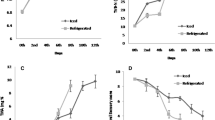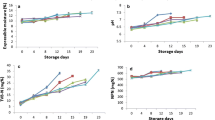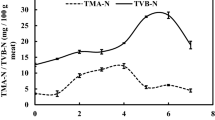Abstract
Octopus (Cistopus indicus) were examined for the changes in autolytic activity, ammoniacal nitrogen, non-protein nitrogen (NPN), total volatile base nitrogen (TVBN), free fatty acid (FFA) content, aerobic plate count (APC) and sensory quality based on Quality Index Method (QIM) during ice storage. They were sensorily acceptable up to 7 days when QIM score was 10.97 out of 16.00. Autolytic activity increased from the initial value of 174 to 619 nmoles Tyr/g/h within day 3 and later decreased. There was also an increase in NPN (34.88 to 76.16 mg %), ammoniacal nitrogen (0 to 7.30 ppm) and free fatty acid content (0.35 to 1.69 % of oleic acid) during storage. TVBN values did not correlate with the spoilage, as it increased from 28 to 145 mg% within day 5, exceeding the limit of acceptability; although total QIM score was 7.47. Aerobic plate count did not show significant change suggesting that the spoilage in octopus was not microbial. The rapid spoilage in octopus was mainly due to the release of NPN compounds following autolytic activity leading to the formation of ammoniacal nitrogen, rather than microbial spoilage. Hence, ammoniacal nitrogen can be taken as an index for spoilage of ice stored octopus.









Similar content being viewed by others
References
Antomaropoulos N, Vyncke W (1989) Determination of volatile bases in fish. Z Lebensm Unters Forseh 189(3):309–316
AOAC (1995) Official methods of analysis (16th ed.) Arlington, VA, Association of Official Analytical Chemists
APHA (1992) Standard methods for the examination of water and wastewater, 18th edn. Water Pollution Control Federation, Washington
APHA (1995) Compendium of methods for the microbiological examination of foods,701 p APHA. New York
Asano M (1957) Biochemistry of octopus (in Japanese). Kagaku no Ryoiki 11:685–692
Atrea I, Papavergou A, Amvrosiadis I, Savvaidis IN (2009) Combined effect of vacuum packaging and oregano essential oil on the shelf life of Mediterranean octopus (Octopus vulgaris) from Agean sea stored at 4 °C. Food Microbiol 26:166–172
Barbosa A, Vaz-Pires P (2003) Quality index method (QIM) development of a sensorial scheme for common octopus (Octopus vulgaris). Food Cont 15:161–168
Botta JR, Downey AP, Lauder JT, Noonan PB (1979) Preservation of raw whole short finned squid (Illex illecebrosus) during the period from catching to processing: skin colour of raw squid and sensory quality of subsequently cooked squid. Fisheries and Marine service Technical Report No.885. Canada: Department of Fisheries and Oceans
Capillas RC, Moral A, Morales J, Montero P (2002) Characterisation of non protein nitrogen in cephalopods volador (Illex coindetii), pota (Todaropsis eblanae) and octopus (Eledone cirrhosa). Food Chem 76:165–172
Gomez-Guillen MC, Martinez-Alvarez O, Montero P (2003) Functional and thermal gelation properties of squid mantle proteins affected by chilled and frozen storage. Food Chem Toxicol 68:1962–1967
Hatate H, Tanaka R, Suziki N, Hama Y (2000) Comparison of protease activity in liver among several species of squid and cuttle fish. Fisheries Sci 66:182–183
Huang Y, Kouadio K, Gates KW (1993) Effect of packaging on chemical changes and quality of refrigerated spot (Leiostomus xanthurus). J Aq Prod Technol 1:111–127
Hurtado JL, Borderias J, Montero P, An H (1999) Characterization of proteolytic activity in octopus (Octopus vulgarius) arm muscle. J Food Biochem 23:469–483
Hurtado J, Montero P, Borderias J (2001) Chilled storage of pressurised octopus (Octopus vulgaris) muscle. Food Chem Toxicol 66:400–406
Huss HH, Dalgaard P, Gram L (1997) Microbiology of fish and fish products. In: Luten B, Borresen T, Oehlenschlager J (eds) Seafood from producer to consumer, integrated approach to quality. Elsevier, Amsterdam, pp 413–43
Joseph SM, Sherief PM (2003) Effect of treatments on the iced storage shelf life of cuttlefish (Sepia aculeata) fillets. Fish Technol 40:32–35
Kruezer R (1984) Cephalopods handling, processing and products. FAO Fish Tech Pap 254:10
Lapa-Guimaraes J, Aparecida AM, Edwardo FP, Contreras GE (2002) Sensory, colour and psychotropic bacterial analyses of squids (Loligo plei) during storage in ice. Lebensmittel-Wissennschaft und-Technologie 35:21–29
Lougovois VP, Kolovou MK, Savvaidis IN, Loannis N (2008) Spoilage potential of ice stored whole musky octopus (Eledone moschata). Int J Food Sci Tech 43:1286–1294
Lowry OH, Rosebrough NJ, Farr AL, Randall RJ (1951) Protein measurement with folin phenol reagent. J BiolChem 193:265–275
Ohashi E, Okamoto M, Ozawa A, Fujita T (1991) Characterisation of common squid using several freshness indicators. J Food Sci 56:161–16
Ohmori H, Hori T, Nakamura K (1975) Preservation of skin colour of squid in refrigerated sea water. Refrigeration 50:435–438
Olafsdottir G, Martinsdottir E, Oehlenschlager P, Dalgaard P, Jensen B, Undeland I (1997) Methods to evaluate fish freshness in research and industry, Trends in research and industry. Trends Food Sci Tech 8:258–265
Paarup T, Sanchez JA, Moral A, Christensen H, Bisgaard GL (2002) Sensory chemical and bacteriological changes during storage of iced squid (Todaropsis eblanae). J App Microbiol 92:941–950
Sungsri-in R (2010) Development of pink colour of squid and effect of chemical treatment on physic-chemical changes of squid during frozen storage. M Sc Thesis, Prince of Songla University. pp 102
Takagi T, Hayashi K, Itabashi V (1984) Toxic effects of free unsaturated fatty acids in mouse assay of diarrheic shellfish toxins by intra peritoneal injection. Bull Jap Soc Sci Fish 50:1413–1418
Vaz Pires P, Barbosa A (2004) Sensory, microbiological, physical and nutritional properties of iced whole common octopus (Octopus vulgaris). Food Sci Technol 37:105–114
Vaz Pires P, Seixas P, Mota M, Lapa-Guimaraes J, Lindo A, Silva T (2008) Sensory, microbiological, physical and chemical properties of cuttle fish (Sepia officinalis) and broad tail shortfin squid (Illex coindetii) stored in ice. Food Sci Technol 41:1655–1664
Venkatappa D (2006) Studies on the ice storage characteristics of octopus, Octopus membranaceus (Quoy and Gaimard). Fish Technol 43:154–161
Acknowledgments
Authors wish to thank the Dean, Fisheries College and Research Institute, Tamil Nadu Fisheries University, Tuticorin, India for having provided necessary support for carrying out this work.
Author information
Authors and Affiliations
Corresponding author
Rights and permissions
About this article
Cite this article
Shalini, R., Shakila, R.J., Jeyasekaran, G. et al. Sensory, biochemical and bacteriological properties of octopus (Cistopus indicus) stored in ice. J Food Sci Technol 52, 6763–6769 (2015). https://doi.org/10.1007/s13197-015-1751-1
Revised:
Accepted:
Published:
Issue Date:
DOI: https://doi.org/10.1007/s13197-015-1751-1




